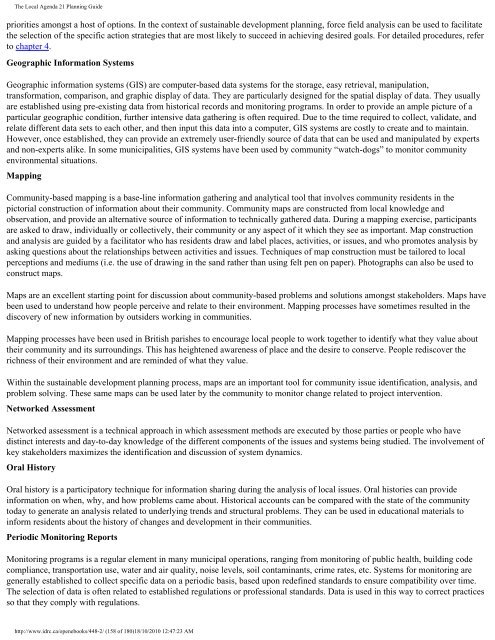The Local Agenda 21 Planning Guide - Democrats Against UN ...
The Local Agenda 21 Planning Guide - Democrats Against UN ...
The Local Agenda 21 Planning Guide - Democrats Against UN ...
You also want an ePaper? Increase the reach of your titles
YUMPU automatically turns print PDFs into web optimized ePapers that Google loves.
<strong>The</strong> <strong>Local</strong> <strong>Agenda</strong> <strong>21</strong> <strong>Planning</strong> <strong>Guide</strong><br />
priorities amongst a host of options. In the context of sustainable development planning, force field analysis can be used to facilitate<br />
the selection of the specific action strategies that are most likely to succeed in achieving desired goals. For detailed procedures, refer<br />
to chapter 4.<br />
Geographic Information Systems<br />
Geographic information systems (GIS) are computer-based data systems for the storage, easy retrieval, manipulation,<br />
transformation, comparison, and graphic display of data. <strong>The</strong>y are particularly designed for the spatial display of data. <strong>The</strong>y usually<br />
are established using pre-existing data from historical records and monitoring programs. In order to provide an ample picture of a<br />
particular geographic condition, further intensive data gathering is often required. Due to the time required to collect, validate, and<br />
relate different data sets to each other, and then input this data into a computer, GIS systems are costly to create and to maintain.<br />
However, once established, they can provide an extremely user-friendly source of data that can be used and manipulated by experts<br />
and non-experts alike. In some municipalities, GIS systems have been used by community “watch-dogs” to monitor community<br />
environmental situations.<br />
Mapping<br />
Community-based mapping is a base-line information gathering and analytical tool that involves community residents in the<br />
pictorial construction of information about their community. Community maps are constructed from local knowledge and<br />
observation, and provide an alternative source of information to technically gathered data. During a mapping exercise, participants<br />
are asked to draw, individually or collectively, their community or any aspect of it which they see as important. Map construction<br />
and analysis are guided by a facilitator who has residents draw and label places, activities, or issues, and who promotes analysis by<br />
asking questions about the relationships between activities and issues. Techniques of map construction must be tailored to local<br />
perceptions and mediums (i.e. the use of drawing in the sand rather than using felt pen on paper). Photographs can also be used to<br />
construct maps.<br />
Maps are an excellent starting point for discussion about community-based problems and solutions amongst stakeholders. Maps have<br />
been used to understand how people perceive and relate to their environment. Mapping processes have sometimes resulted in the<br />
discovery of new information by outsiders working in communities.<br />
Mapping processes have been used in British parishes to encourage local people to work together to identify what they value about<br />
their community and its surroundings. This has heightened awareness of place and the desire to conserve. People rediscover the<br />
richness of their environment and are reminded of what they value.<br />
Within the sustainable development planning process, maps are an important tool for community issue identification, analysis, and<br />
problem solving. <strong>The</strong>se same maps can be used later by the community to monitor change related to project intervention.<br />
Networked Assessment<br />
Networked assessment is a technical approach in which assessment methods are executed by those parties or people who have<br />
distinct interests and day-to-day knowledge of the different components of the issues and systems being studied. <strong>The</strong> involvement of<br />
key stakeholders maximizes the identification and discussion of system dynamics.<br />
Oral History<br />
Oral history is a participatory technique for information sharing during the analysis of local issues. Oral histories can provide<br />
information on when, why, and how problems came about. Historical accounts can be compared with the state of the community<br />
today to generate an analysis related to underlying trends and structural problems. <strong>The</strong>y can be used in educational materials to<br />
inform residents about the history of changes and development in their communities.<br />
Periodic Monitoring Reports<br />
Monitoring programs is a regular element in many municipal operations, ranging from monitoring of public health, building code<br />
compliance, transportation use, water and air quality, noise levels, soil contaminants, crime rates, etc. Systems for monitoring are<br />
generally established to collect specific data on a periodic basis, based upon redefined standards to ensure compatibility over time.<br />
<strong>The</strong> selection of data is often related to established regulations or professional standards. Data is used in this way to correct practices<br />
so that they comply with regulations.<br />
http://www.idrc.ca/openebooks/448-2/ (158 of 180)18/10/2010 12:47:23 AM










